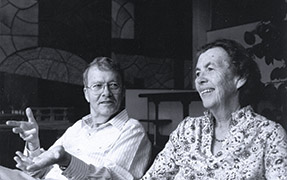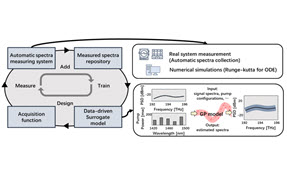A plasmonic 'bull's-eye' nanoresonator
Optical fibers and interconnects can carry vast amounts of information across the globe at the speed of light. However, the size and performance of photonic networks is limited by diffraction: because only a small amount of light can pass through a hole that is narrower than the wavelength of the light, the transmitted light emerges in all directions. In telecommunications, light typically has a wavelength of 1500nm and cannot pass though the channels used to guide electrons in conventional chip-based electronic devices that have features as small as 20nm. This means that optical components cannot be easily integrated on the same scale as conventional devices.
To address this problem, the newly emerging field of plasmonics is using light waves to excite the wavelike motions of electrons that propagate on the surface of a conductor, usually a metal. Trapped on the surface because of their interaction with the free electrons of the conductor, they are also called surface plasmon polaritons (SPPs). Unlike the light waves themselves, SPPs can be used to guide light through grooves that are much narrower than the wavelength of the light used. Recent research has demonstrated the ability to ‘squeeze’ light to dimensions much smaller than the diffraction limit, allowing it to pass though small regions such as channels on a chip without being significantly lost, thus enabling nanoscale optical switches and waveguides that can quickly route data within a microchip.1 The confinement of SPPs in the interface between a metal and a dielectric (insulating) material, such as silver/air, has led to a broad range of applications from cancer therapy2 to invisibility cloaks3 and beyond.

For a given energy, SPPs will have a wavelength shorter than their free-space counterpart. The electric field of an SPP has a maximum at the metal/dielectric interface and decays exponentially perpendicular to the interface in both materials. Moreover, SPPs are guided waves that do not radiate and are thus confined to the interface. Because the momentum of the SPPs generally exceeds that of a photon, they are typically excited optically using a prism or grating to couple the incident light to the surface wave. Near-field optical techniques can also excite plasmonic resonant structures with optical probe sizes as small as 20nm.4 Alternatively, a focused electron beam can be used to directly and locally excite SPPs with higher spatial resolution, and without the necessity of generating and coupling an incident photon. Electron energy loss spectroscopy (EELS) in the transmission electron microscope (TEM) has been used to visualize plasmonic modes in metal nanoparticles,5 nanorods,6,7 and nanotriangles8 with a spatial resolution limited only by the electron beam diameter, which can be as small as 1nm.
TEM however, requires samples to be electron-transparent, i.e., with thicknesses less than 100nm. This is not the case with cathodoluminescence (CL) excitation using a scanning electron microscope (SEM). SEM electron beam excitation yields CL emission, which has recently been used to investigate the propagation of SPPs along planar metal surfaces and linear gratings9,10 and to image modes in gold nanowires.11 In our work, we have extended this technique to the investigation of modes in nanofabricated plasmonic annular nanoresonators.12


Metallic nanoresonators were fabricated on silver and gold surfaces using focused ion beam (FIB) nanofabrication. Each annular resonator is composed of a center plateau and five concentric rings separated by grooves 50nm deep, with varying grating ring period and center diameters (see Figure 1). In these structures, the electron beam can directly excite localized SPPs that couple to resonant plasmonic modes.
Spectrally resolved CL analysis was performed using a field emission SEM operating at 30keV and equipped with a mirror-based CL detection system (see Figure 2). The spatial resolution in excitation was limited only by the electron beam spot size (5nm). Light emitted from the sample was collected with a retractable paraboloidal mirror positioned above the sample (collection angle up to ±80° from the surface normal). CL images were obtained by setting the grating monochromator to a specific wavelength and scanning the electron beam over a selected area of the sample. Secondary electron and CL images were simultaneously recorded.
The first three lowest-order plasmonic modes of an annular nanoresonator with a 620nm-center diameter and a 315nm grating period are shown in Figure 3. Experimental linescans (CLexp) are plotted alongside simulated CL intensity (CLsim) and time-averaged electric field intensity (〈 |E| 〉2) profiles for each mode. At λ=l700nm, the experimental CL data display bright emission for excitation near the edges of the center plateau, but uniform emission from the rest of the structure. This is consistent with excitation of the lowest-order mode, where simulations show that high fields are localized at the edges of the center region and not in the surrounding rings (mode M0,0). The second mode, M1,0, is imaged at λ=600nm and characterized by an antinode in the resonator center that is captured in both experimental and simulated line profiles. The onset of the third mode (M0,1) is observed at λ=500nm, with four peaks in the center region revealed in the CLexp line profile. Comparing the experimental and theoretical linescans, it is clear that regions of enhanced CL emission in the center plateau correlate well with the simulated electric field intensity and CL profiles for each mode.12 Thus, we conclude that CL in annular resonators is most efficiently excited at positions that correspond to antinodes in electric field intensity.
Our work demonstrates that the highly localized electron beam of an SEM can be used to excite metallic annular nanoresonators, and that spectrally resolved CL can image their plasmonic modes with unprecedented resolution. This represents the first application of spectrally resolved CL imaging to reveal modes in complex plasmonic resonators. Since the investigation of such structures is crucial for the design of new plasmonic devices, CL may be the experimentalists' bull's-eye for nanoscale characterization.
This work was performed in collaboration with L. A. Sweatlock and H. J. Lezec (Caltech), E. J. R. Vesseur and A. Polman (Institute for Atomic and Molecular Physics of the Foundation for Fundamental Research on Matter (FOM), Amsterdam, the Netherlands), and F. J. Garc´ia de Abajo (Institute of Optics, CSIC, Madrid, Spain). Financial support was provided by the Air Force Office of Scientific Research under MURI grant FA9550-04-1-0434. This work is also part of the FOM research program supported by the Netherlands Organisation for Scientific Research. CL measurements were performed at the Amsterdam NanoCenter. C.E.H. acknowledges fellowships from the National Science Foundation (NSF) and the Department of Defense.
Carrie E. Hofmann is a doctoral candidate in materials science. She received her BS in materials science and engineering at the University of Florida in 2003. She is a recipient of both NSF and National Defense Science and Engineering Graduate fellowships. Her research interests include novel methods of electron-beam excitation and localization of modes in plasmonic resonant structures.
Harry A. Atwater is currently Howard Hughes Professor and a professor of applied physics and materials science. His research interests are multidisciplinary and centered on subwavelength-scale photonic devices based on surface plasmons, nanocrystal electronic and optoelectronic devices, photovoltaics, and ferroelectric and piezoelectric active thin-film materials and devices. He received his BS in 1981, his MS in 1983, and his PhD in 1987.



